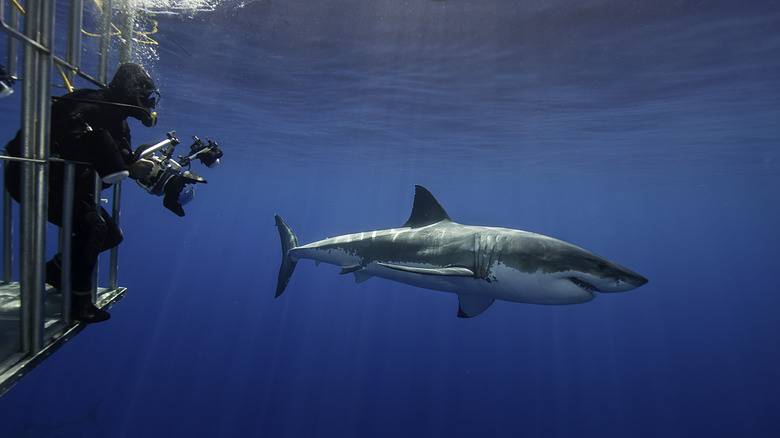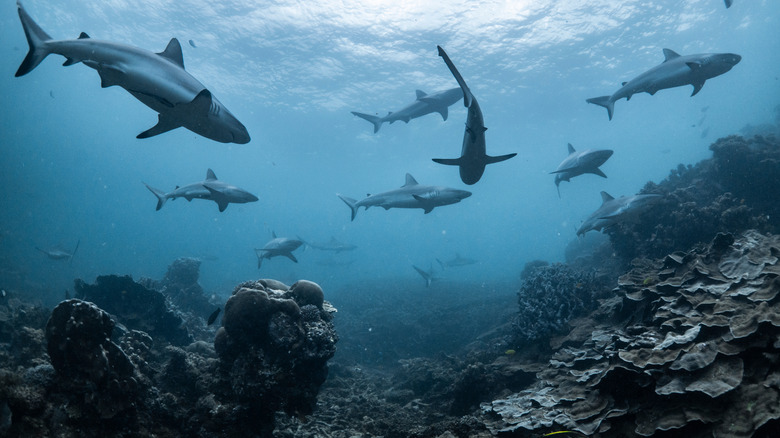Why The Antics Of Social Media 'Sharkfluencers' Are Problematic For Snorkelers And Divers
No two notes immediately bring to mind impending danger more than the score from "Jaws" — one of the most recognizable movie themes. The dread-inducing "duh-nuh" has been used, mostly as parody, in over 130 movies and shows since the film's 1975 premiere. In "Jaws," the object of that dread was the human-stalking, flesh-eating terror of the ocean: a 25-foot great white shark, which kills five people and a dog during the course of the film. After its release, over one-third of viewers claimed to feel more afraid of swimming in the ocean, and beach visits decreased significantly — a phenomenon that became known as the "Jaws Effect."
So, should beachgoers be worried about rising shark attacks? Experts say no, as this fear is mostly unwarranted. In 2024, there were just 47 unprovoked shark attacks, with only four resulting in fatalities. Of course, any death is tragic, but to put this number into perspective, 480 people have died taking selfies (as of the end of 2024). This averages to 5 or 6 deaths annually and makes selfies more dangerous than sharks. Conversely, humans kill a staggering 100 million sharks a year (the number might be as high as 273 million), mostly as bycatch in harmful commercial fishing practices, as well as to feed the growing demand for shark meat. So, these apex predators, who play an important role in maintaining balance in fragile marine ecosystems, have much more reason to fear us.
Enter the new generation of digitally savvy divers and conservationists, known as "sharkfluencers," who are working to raise awareness about the plight of sharks worldwide, particularly through visual content on social media platforms like TikTok, Instagram, and YouTube. And although most have good intentions, their continued antics may prove problematic for snorkelers, divers, and other underwater enthusiasts.
The rise of the 'sharkfluencer'
Sharkfluencers have populated the social mediascape for years now, with messages on why sharks are important, accompanied by videos of the animals gliding gracefully through the ocean. This content undoubtedly had a positive impact in raising money for conservation initiatives and educating the public about shark behavior. However, their methods have been called into question. Eco-tourism operator Jim Abernethy posts videos of divers petting and kissing docile-looking sharks, accompanied by messages that encourage "making friends with sharks" and plugs for his own company's trips. Conservationist Andriana Fragola's top-viewed post shows her redirecting an approaching shark with her hand, with the caption: "Sharks teach me to be my most powerful self" (via Instagram).
Arguably the most famous sharkfluencer is Ocean Ramsey, a freediver, conservationist, and star of the Netflix documentary series "Shark Whisperer." Amassing over 315,000 followers on TikTok and 2.5 million on Instagram as of this writing, Ramsey has been criticized for riding sharks in Mexico and for swimming alongside and touching a pregnant great white in Hawai'i. In the latter incident, she was accused of misrepresenting how dangerous her actions were through a lack of context — the massive shark's "mellow" state was because she had just feasted on a whale carcass and was likely in a near-comatose state.
Although the data indicate that shark-related incidents are low, they may unfortunately rise in the future, as people continue to approach them. Some critics believe that sharkfluencers might be at least partially to blame. They may not explicitly promote direct contact (and some expressly discourage it), but by filling their social media feeds with imagery of human-shark interactions, the message is mixed, and actions speak louder than words.
How and where to encounter sharks safely and responsibly
Swimming with sharks can be a meditative, joyful, and memorable experience. Thankfully, there are many stunning places for you to enjoy safe encounters with these majestic animals. In Oceania, head to Marovo Lagoon in the Solomon Islands, the world's largest saltwater lagoon in a tropical paradise. Here, you can view the area's enormous resident population of grey reef sharks. In Asia, take a boat ride from Malapascua to the tiny underwater Philippine island of Monad Shoal that's perfect for adventurers. Watch groups of elegant thresher sharks as they receive their morning dental treatment (where cleaner fish remove irritating parasites from the sharks' mouths). And in Central America, dive around the many stunning sites near Cocos Island National Park, the Costa Rican island known for having one of the best shark dives in the world. You'll encounter Galapagos sharks, scalloped hammerheads, tiger sharks, and more. When booking your trip, look for ethical tour operators — typically, they will not encourage selfies or physical contact.
Regardless of your thoughts on the aforementioned sharkfluencers' antics, many of them are marine biologists and professional divers with years of experience working with sharks. In most cases, other people do not have that background and shouldn't be attempting any of those interactions. Remember always to maintain a safe distance, avoid rushing towards the sharks, and refrain from trying to attract or harass them in any way. Besides the danger you're putting yourself in, it's also essential to consider the animal's safety. As NOAA stresses in its guidelines on viewing marine life, "your actions should not cause a change in an animal's behavior." The energy they expend on trying to escape from you may be energy that they won't have later to find food or protect their young.

